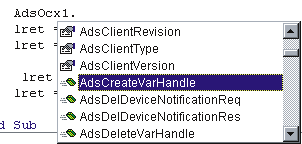Interface to Windows applications
Data connection based on Microsoft standards
TwinCAT integration in Microsoft operating systems allows the use of PC resources (hard disk, network, graphics, and interfaces, etc.) with the methods and through the interfaces of the operating system. At the same time, the exchange of data between real time software for automation purposes must perform certain tasks
- Synchronization with the operating system,
- Adaption of data representation (data alignment),
- Guaranteeing data consistency in the event of access.
A data interface must above all
- fulfill the requirements of automation,
- ensure full integration into the operating system.
Full integration allows the use of standards
With the approach of full integration into operating system methods, compatibility for the use of automation software by all Windows programs is guaranteed, i.e. a typical Windows application can be linked directly with automation programs.
OLE, DCOM+, OCX: Microsoft standards
The modern methods for the use of software technology go by the names of COM, DCOM, OLE, OCX and ActiveX. Describing them fully would fill volumes. Based on OLE (Object Linking and Embedding) technology, with COM (Component Object Model), a tool was introduced to enable an exchange of data objects between programs in a standard fashion, i.e.: OLE allows a Word application to display an Excel table. The improvements in OLE lead to a solution to the general problem of how to use data of an external program and its representation methods (in this case tables, for example) in another program (COM). COM-based data exchange allows access to objects and their data through defined software interfaces and methods. With DCOM (Distributed COM), this also functions between computers in a network. To enable the use of these technologies in controls (applications), OCX (OLE Controls) and ActiveX (OCX with Web expansions) were introduced to expand the existing concepts of COM technology and to reformulate them. OCX and ActiveX are components that are installed very easily, and which then offer data and methods for programs. Therefore, there is no need to write drivers.
OCX automates linking of programs
Nowadays, most programs use OCX interfaces, which enable wide ranging automation of software linking. A large software market for OCX and ActiveX components, which can be integrated into users' own software applications, exists.
TwinCAT interface also available as a DLL
For other applications, the TwinCAT interfaces are also available in the form of a DLL (Dynamic Link Library) and can be integrated.
TwinCAT OCX interface operates via message router
The data link to TwinCAT servers is always established via the message system. In this way, Windows applications can not only operate with local servers, but can also exchange data worldwide with all logged-in TwinCAT servers. The message router ensures an exchange of data even with re-mote servers on other PCs or field devices.

Windows applications access TwinCAT via the message router
Interface for program applications
To be able to use Beckhoff TwinCAT technology, it does not suffice to simply establish a simple data link to visualization applications: A complete interface for programming languages (Visual Basic, Visual C, Delphi, Java...) not only offers "simple" tags to I/O data, but also full access to methods of the PLC / NC one-time servers (starting and stopping and program loading etc.)

Beckhoff ADS OCX offers access to data and methods of the servers
TwinCAT OCX organizes the exchange of data
Beckhoff OCX organizes the exchange of data between TwinCAT and Windows applications. It includes:
- Access by variable name,
- Timing synchronization with the operating system,
- Adaption of the various data types,
- Blocking of data to enhance system effectiveness,
- Adaption of data representation (data alignment),
- Guaranteed data consistency during accesses.
Access methods: - synchronous- asynchronous- cyclic
The access methods allow synchronous access by Windows applications to TwinCAT servers: Windows applications "wait" for the result of a query. Alternatively, asynchronous, or cyclic access is also possible.
Access methods: notify on change is the optimum
The generally most advantageous method of data exchange is the "Notify on change" method: it forms a generic set of asynchronous and cyclic links and only generates activities when a data item really changes. To limit the system load for data exchange, it is possible to set a minimum data transfer cycle time.
Integration in NT: new applications become possible
Thanks to integration and complete use of the Microsoft data interfaces, the Windows software application is becoming available for automation technology. New applications will arise from the fusing of information technology with automation technology. Solutions for users can be combined easily. TwinCAT supports these new applications by complete integration of the interfaces in the COM model and its enhancements.